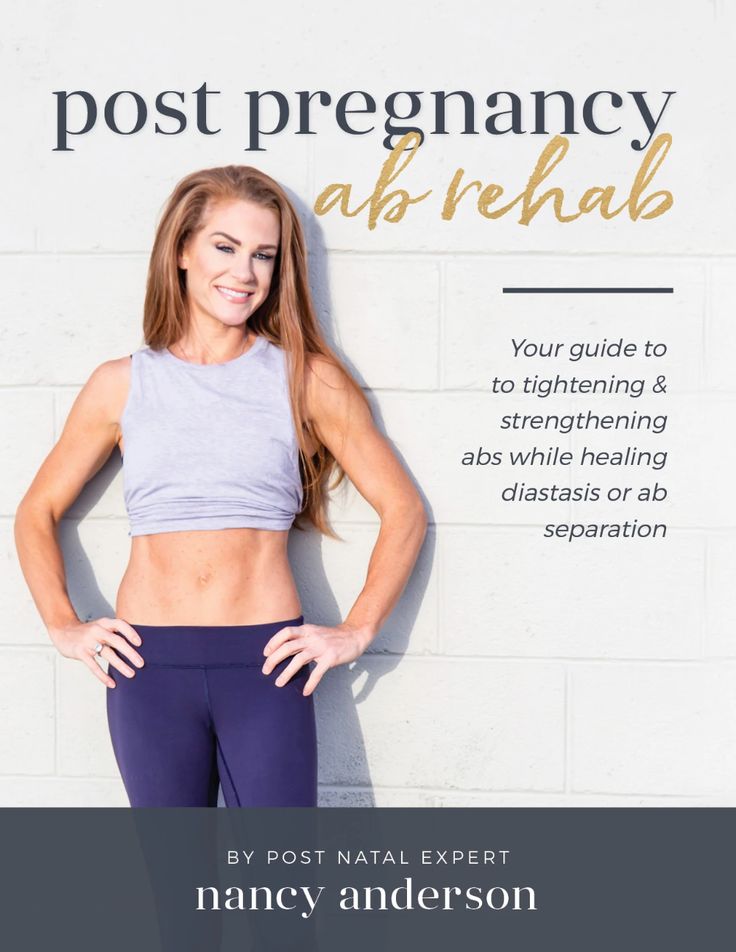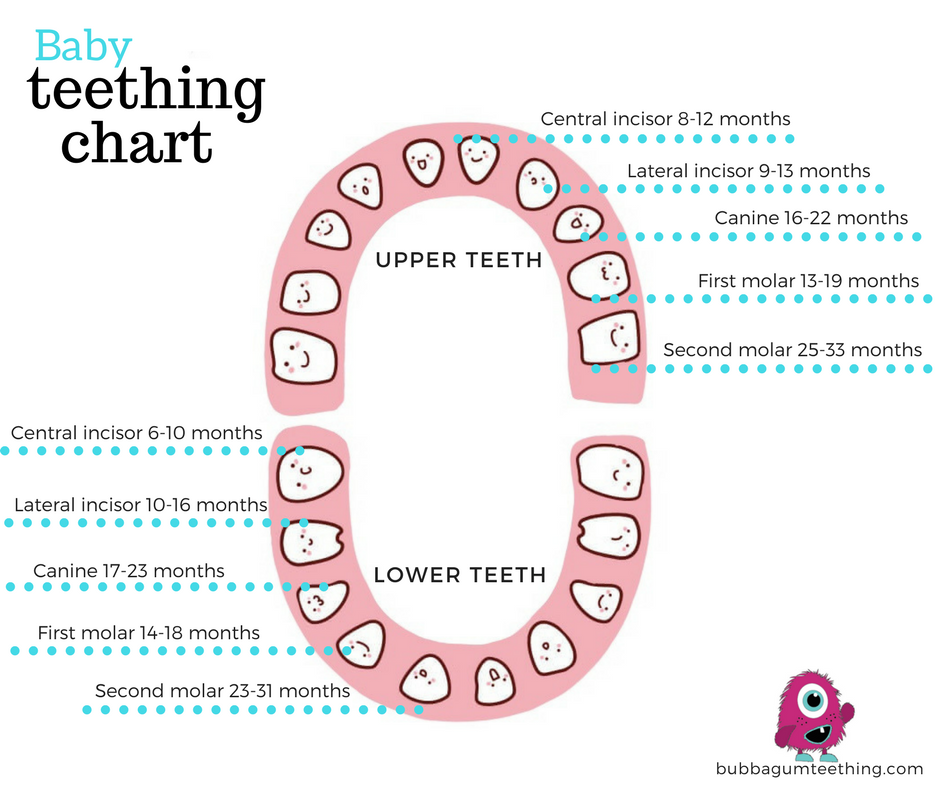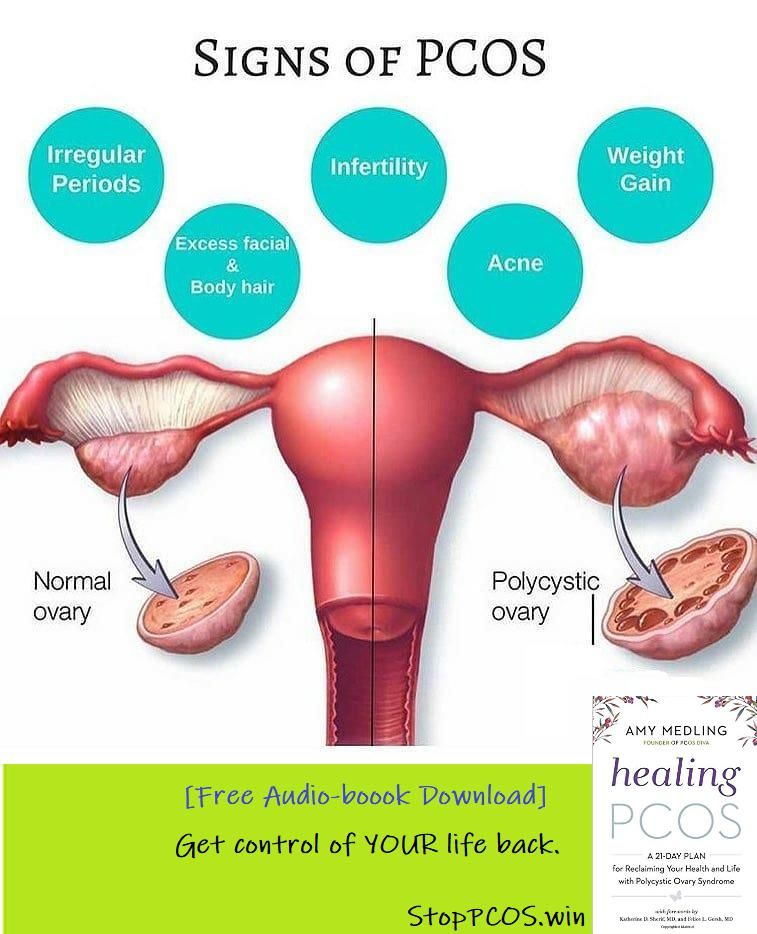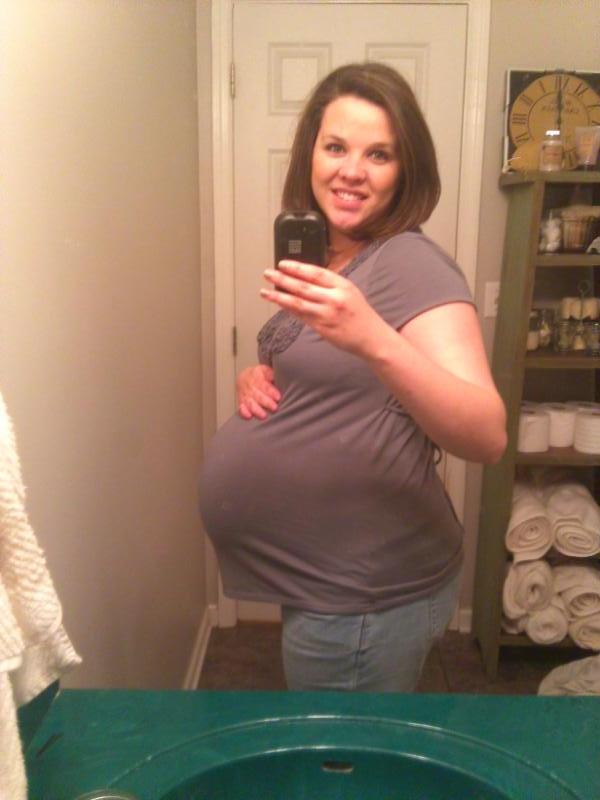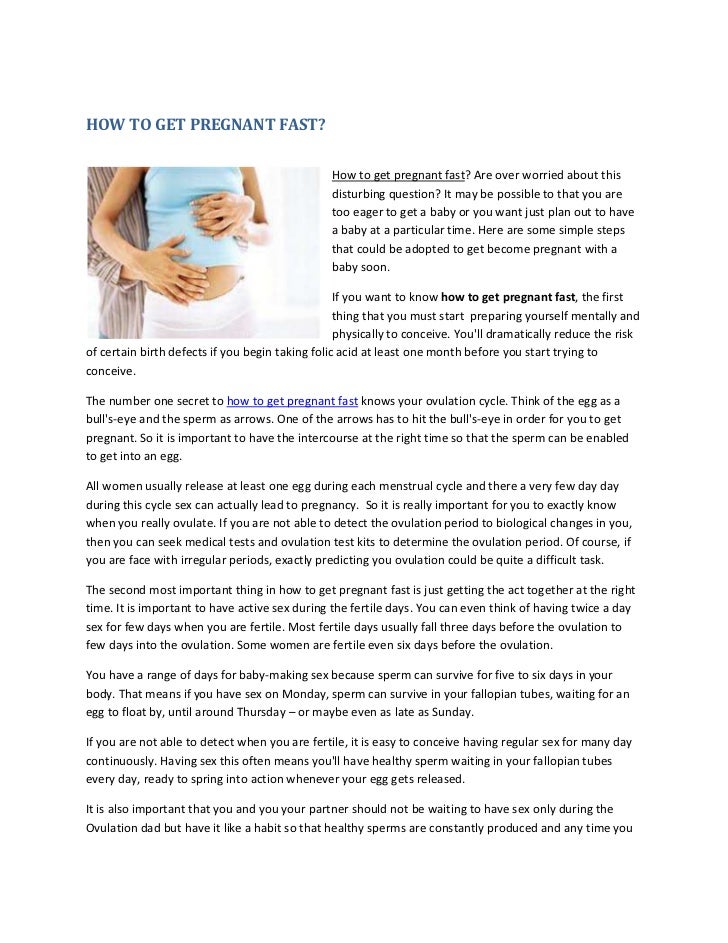Abs workout post pregnancy
Ab rehab: post-baby ab exercises
During the third trimester of pregnancy, babies grow rapidly and put increasing pressure on the abdominal muscles. That pressure can cause the rectus abdominis, a paired muscle running vertically down the front of the abdomen, to separate. This separation is called diastasis recti, and it can occur to various degrees above or below the belly button.
If not corrected postpartum, diastasis recti advances with each pregnancy, and may lead to less abdominal support during future pregnancies, which increases lower back pain and poor posture.
To check for separation, lie flat on your back and lift your head and shoulders off the floor. You should be able to feel the two straps of muscle running vertically along the midline of the abdomen. One or two fingers of space between the two straps is common postpartum. This degree of separation is common in women following the birth of a baby and can be corrected by doing modified abdominal exercise, says Skylar Hill-Jackson, founder and director of Baby & Me Fitness in Toronto. The exercises below pull the two sides of the rectus muscle toward the midline to stabilize and support the abdomen.
Start with the first exercise in the early weeks and gradually add more repetitions, and then move on to the others, recommends Hill-Jackson.
Don’t forget to breathe!
During each exercise, inhale through the nose so that the chest opens and expands, breathing into the lower back and sides of the torso. Exhale through the mouth, pulling the abdominal muscles in toward the spine. Relax and breathe normally between sets.
1. Head lift
Lie on the floor on your back, with knees bent and feet flat on the floor. Cross arms across the belly button at the waist, using hands to pull side ribs together toward the centre of the torso. Or, use a scarf to help pull the side ribs in as shown above. Press the lower back to the floor. Inhale. Exhale and lift the chin slowly toward the chest pulling the abs in toward the spine. Shoulders remain on the floor.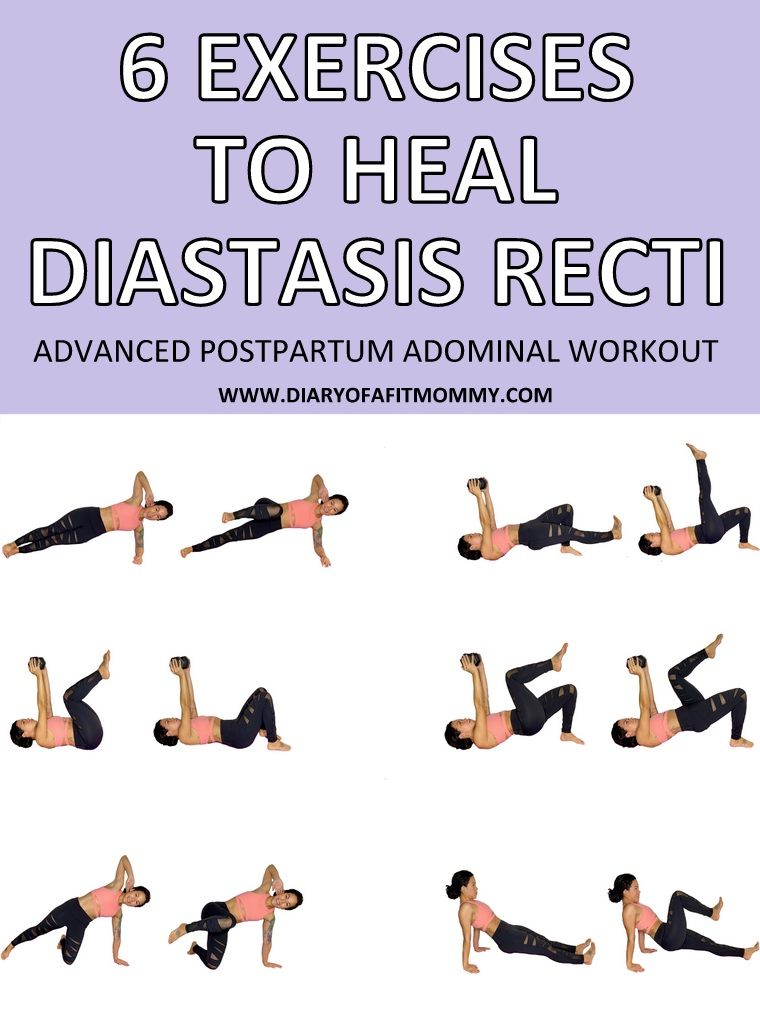 Inhale and release slowly, head on the floor.
Inhale and release slowly, head on the floor.
Repetitions: 4–8, several sets a day, working up to 40 repetitions per day.
2. Pelvic tilt
Use the same starting position as the first exercise, with arms pulling the side ribs toward each other. Inhale. Exhale and pull belly toward spine, tilting pelvis forward toward the belly button. Lower back is pressed to the floor. Inhale and release the pelvic tilt to a relaxed spine.
Repetitions: 4–8, several sets a day.
3. Alternating heel slide
Using the same basic position as in the first two exercises, press the lower back to the floor (small pelvic tilt). Inhale. Exhale, sliding right foot forward until leg is straight along the floor. Keep lower back pressed to the floor. Inhale. Exhale and bring leg back in, foot flat on floor. Repeat on other side.
Repetitions: 4–8, alternating sides, several sets a day.
4. Double heel slide
Press lower back to the floor (small pelvic tilt). Inhale. Exhale and slide both feet forward along the floor until legs are bent but close to the floor. Keep lower back pressed to the floor. Inhale and bring legs back in, feet flat on floor and knees bent.
Inhale. Exhale and slide both feet forward along the floor until legs are bent but close to the floor. Keep lower back pressed to the floor. Inhale and bring legs back in, feet flat on floor and knees bent.
Repetitions: 4–8, several sets a day.
5. Single foot touch
Press lower back to the floor (small pelvic tilt). Lift legs to 90° angle (parallel to the floor). Inhale. Exhale and lower right foot to floor. Inhale and lift foot up to original position. Keep lower back pressed to floor. Repeat with other leg.
Repetitions: 4–8, alternating sides, several sets a day.
Stay in touch
Subscribe to Today's Parent's daily newsletter for our best parenting news, tips, essays and recipes.- Email*
- CAPTCHA
- Consent*
Yes, I would like to receive Today's Parent's newsletter. I understand I can unsubscribe at any time.**
FILED UNDER: Family fitness
8 Diastasis Recti Exercises (10 Min Abs After Baby)
Postpartum Abs + Core (Diastasis Recti Exercises)
By: Lindsey Bomgren, CPT | November 4, 2020
Rebuild core strength and repair Diastasis Recti (DR) with these 8 Diastasis Recti exercises.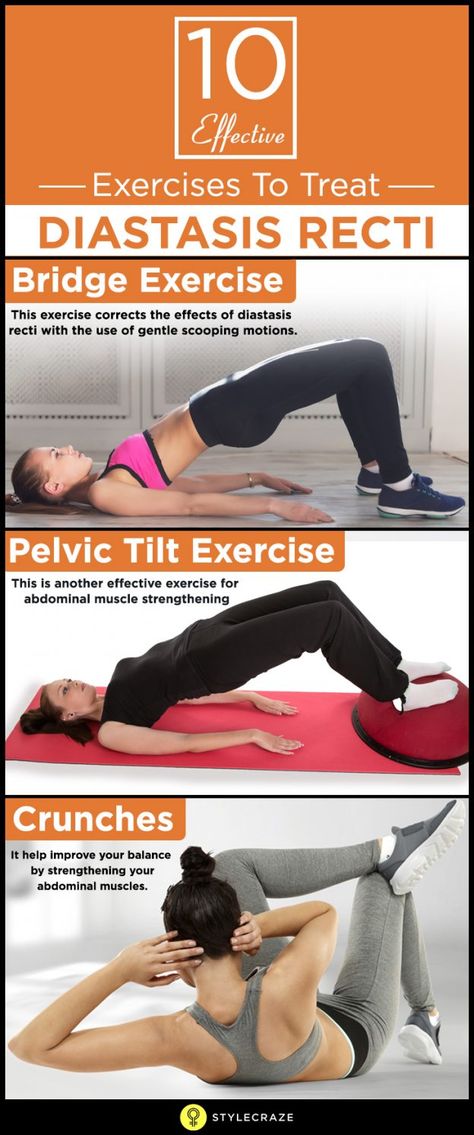 This 10 minute post baby ab workout is designed to help you rebuild your abs after baby by specifically targeting the transverse abdominals and pelvic floor muscles (both of which are weakened during pregnancy).
This 10 minute post baby ab workout is designed to help you rebuild your abs after baby by specifically targeting the transverse abdominals and pelvic floor muscles (both of which are weakened during pregnancy).
Jump to Workout
My 30 Minute Advanced Pregnancy Workout is my most popular workout video on YouTube (and how you might have discovered NML).
You might have even followed my Pregnancy Workout Plan (note, I also have a FREE, 30 Day Postpartum Workout Plan).
But how do you get safely get back into exercise after having a baby?I remember being so over AND underwhelmed with the amount of information available around how to care for my body after baby.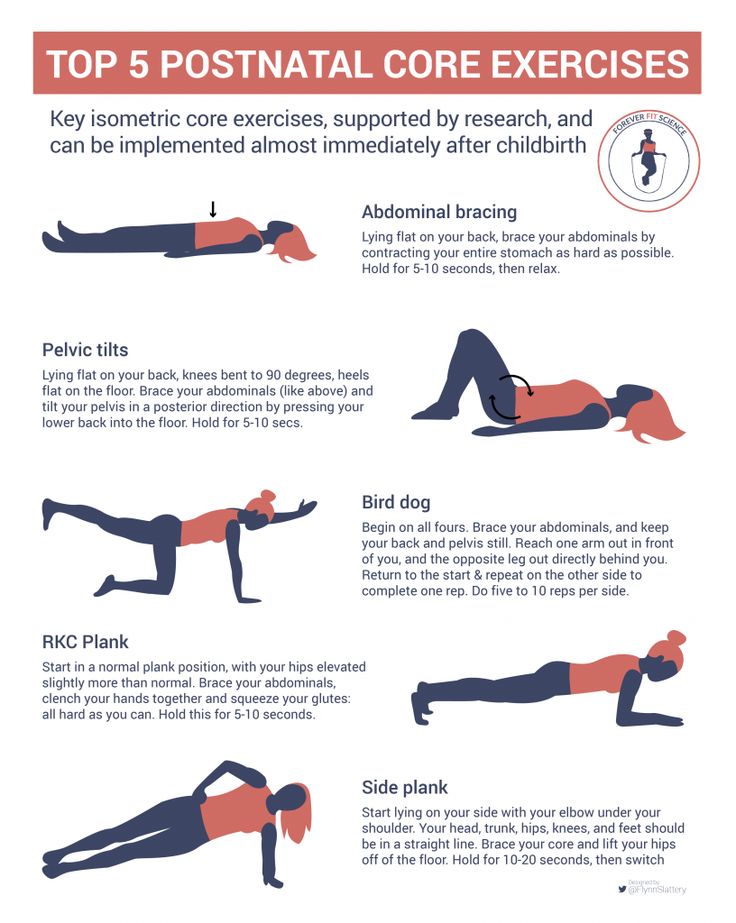
If you’re pregnant, bookmark this page to come back to postnatal.
And if you’re post-pregnancy (whether 2 weeks, 2 months, 2 years or more) — keep on reading, this 10 minute abs after baby workout for you!
When can I start working out after baby? Or how soon after giving birth can I exercise?Every body, every pregnancy, and every birth is so different. It’s hard to give a black-and-white rule about when it’s safe to return to exercise postpartum.
If you had an uncomplicated pregnancy and vaginal delivery, it’s generally safe to begin exercising a few weeks after giving birth or as soon as you feel ready. If you had a C-section, extensive vaginal repair or a complicated birth, talk to your health care provider about when to start an exercise program (MayoClinic).
I personally started using these 8 Diastasis Recti exercises around two weeks post-baby.
I started with the first four exercises for diastasis recti repair.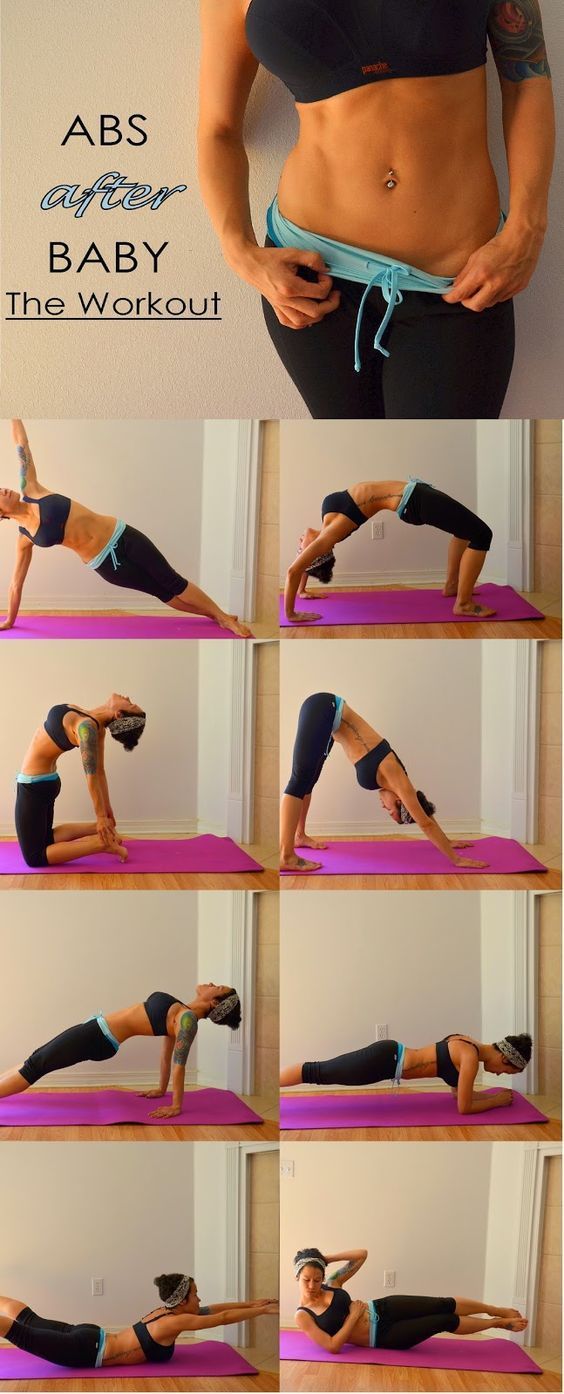 I progressed up to all eight post-baby ab exercises around 6-8 weeks postpartum.
I progressed up to all eight post-baby ab exercises around 6-8 weeks postpartum.
Diastasis Recti is the separation of the right and left ab muscles at the midline of the abdomen. If the ab separation becomes greater than 2 cm, then you have DR.
DR is also commonly referred to as the ‘mom pooch’ or ‘lower belly pooch.’
In my case, and in the case of most women who develop DR, this happens when the abdominal muscles separate during pregnancy. According to this study on Diastasis Recti up to 66% of pregnant women will experience DR by their third trimester.
This happens when the abdominal muscles separate during pregnancy. The growth of the belly stretches the linea alba (you can see what abdominal separation looks like after pregnancy in this diagram from Mayo Clinic).
If you’re wondering…
How do I know if I have Diastasis Recti?Learn how to check for Diastasis Recti at home here.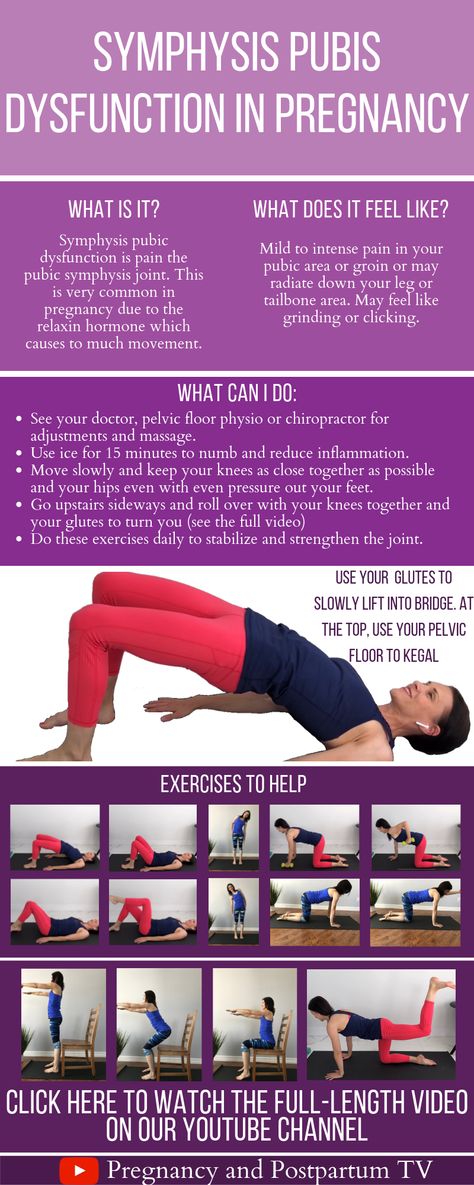 I filmed this video with my pelvic floor physical therapist (Dr. Jenn).
I filmed this video with my pelvic floor physical therapist (Dr. Jenn).
Sympoms of diastasis recti include:
- Low back pain
- Urinary or bowel problems
- Poor posture
- Difficulty performing load transfer tasks necessary for bending, reaching, lifting, carrying, squatting, walking, and stair climbing (all the activities that new moms quickly become experts in)
Sometimes, Diastasis Recti will heal itself, but other times it may require physical therapy (I suggest seeing a pelvic floor physical therapist).
I also highly recommend check out this interview I did with Dr. Jenn: 10 Things You Need to Know About Your Pelvic Floor After Baby!
10 Minute Abs After Baby
This postnatal ab workout is specifically designed to heal Diastasis Recti, strengthen your core and pelvic floor, and rebuild deep core muscles after pregnancy.
Let’s be honest, Diastasis Recti workouts aren’t very exciting.
That’s why I created a guided, follow along workout video for this post-baby ab workout. I’ll coach you through each exercises, offering form cues and modifications for everyone depending where you are in your Diastasis Recti repair journey.
I’ll coach you through each exercises, offering form cues and modifications for everyone depending where you are in your Diastasis Recti repair journey.
This workout specifically targets the deep transverse abdominals and pelvic floor muscles (both of which are weakened during pregnancy) to rebuild your core!
Workout Equipment:No equipment needed, just your bodyweight.
Workout Instructions:Follow along with the guided, 10-Minute Abs After Baby Workout Video on YouTube, led by certified personal trainer and prenatal fitness instructor, Lindsey Bomgren.
Alternatively, work through the 8 best diastasis recti core exercises below at your own pace:
- 8 Ab Exercises
- 30 Seconds Per Exercise
- Repeat x2 Sets
- *Note: Start where you are and do what you can! Maybe you start by performing the first three exercises for 20-30 seconds, rest and repeat.
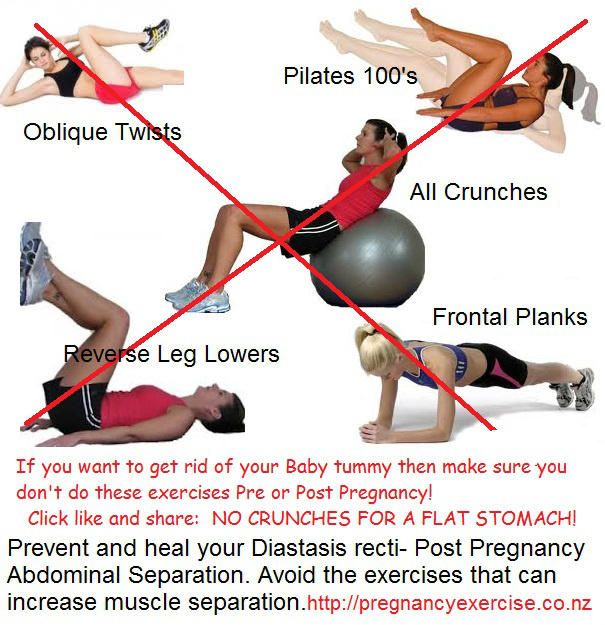 Then slowly add on exercise 4, then 5, and progress your way up to completing all eight exercises. You can always work up to performing these exercises for 45-60 seconds.
Then slowly add on exercise 4, then 5, and progress your way up to completing all eight exercises. You can always work up to performing these exercises for 45-60 seconds.
8 Best Diastasis Recti Exercises
- Transverse Abdominal Breathing (TVA breathing) + Core Connection
- Lying Heel Tap + Leg Lift
- Lying Bent Knee Pulls
- Elevated Bent Knee March
- Elevated Leg Extension + Leg Drop
- Elevated Leg Extension + 2 Circles
- Elevated Bent Knee V-Taps
- Elevated First Position Kick Outs
Targets: the deep transverse abdominal muscles (TVA) and pelvic floor muscles. These muscles support your internal organs, your inter-abdominal pressure system, and provide stability an mobility of your lower spine.
Transverse abdominal breathing is hands down the number one core strengthening exercise I recommend to ALL women (pregnant or postpartum).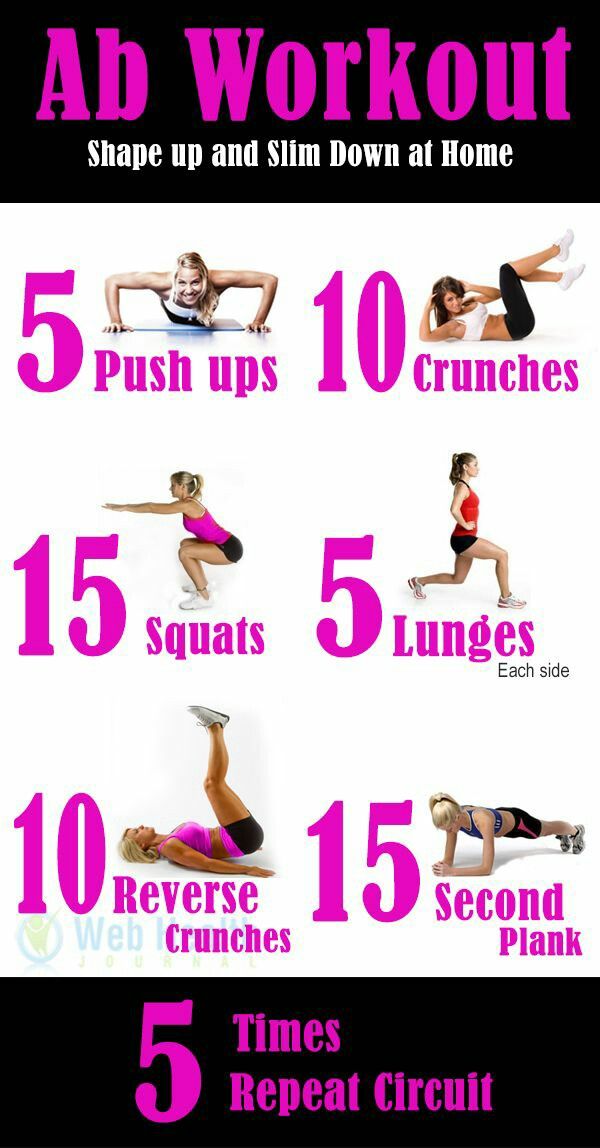 It’s how you learn to posteriorly tilt your pelvis, which is important for ALL of the following exercises.
It’s how you learn to posteriorly tilt your pelvis, which is important for ALL of the following exercises.
TA breathing is difficult to explain in text or still images, so I recommend you watch the video at the top of this page (from 01:45 to 2:55) for a full demonstration of TA breathing.
- You want this entire movement to come just from your belly.
- Hold the inhale for 1 second, and then slowly begin to exhale.
- Exhale, as much as you possibly can over 5 seconds, while pulling your belly button down towards the mat. Focus on squeezing your TVA muscles, posteriorly tilting your pelvis, in the exhaled position.
Targets: transverse abdomen, lower abs and hips.
- With your low back pressing firmly into the mat and your abdominal wall wrapped as tightly as possibly around your core, tap or slide one heel away from your body.
- Then, trying to keep your extended leg as straight as possible, raise your leg off the ground to return to the starting position.
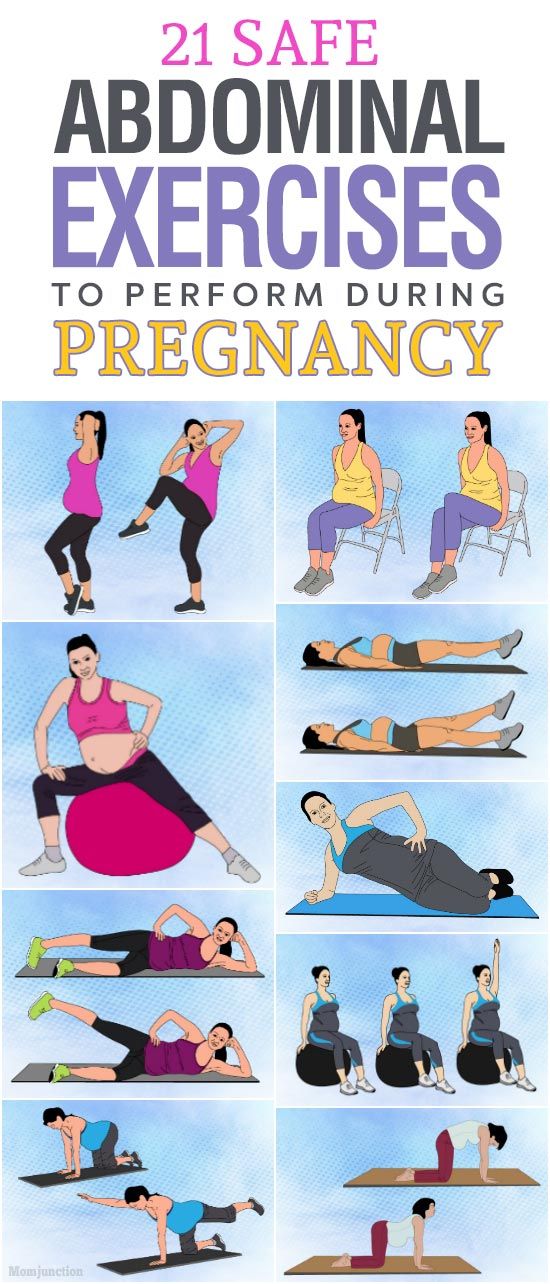
To modify, take out the leg raise and only perform the heel taps.
3. Lying Bent Knee PullsTargets: transverse abdomen, lower abs and hips.
- With your low back pressing firmly into the mat and your abdominal wall wrapped as tightly as possibly around your core, alternate pulling one knee towards your chest.
- Hold knee to chest for a 2-3 count and switch legs.
To modify, keep your extended leg on the mat.
4. Elevated Bent Knee MarchTargets: transverse abdomen, lower abs and hips.
- With your low back pressing firmly into the mat and your abdominal wall wrapped as tightly as possibly around your core, bring your legs to a 90 degree bend.
- Note, the closer your knees are to your chest the easier this ab exercise will be. The farther your knees are from your chest, the harder this Diastasis Recti exercise will be.
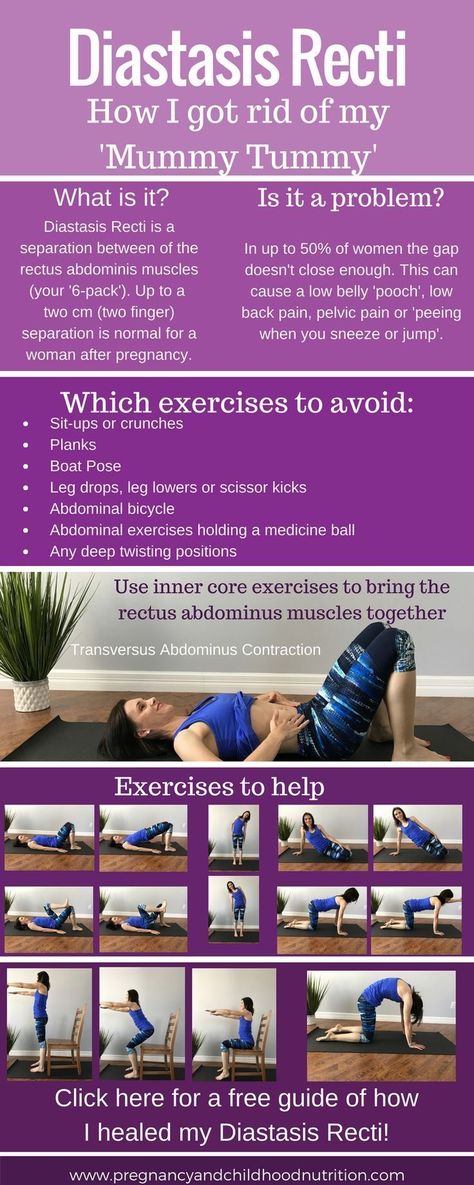
- Alternate tapping one toe towards the ground, return to starting position, and tap the other toe towards the ground. This movement is slow and controlled.
To modify, keep both toes on the ground and alternate lifting one knee towards your chest and switch.
5. Elevated Leg Extension + Leg DropTargets: transverse abdomen, upper abs, lower abs and hips.
- With your low back pressing firmly into the mat and your abdominal wall wrapped as tightly as possibly around your core, bring your legs to a 90 degree bend.
- Note, the closer your knees are to your chest the easier this ab exercise will be. The farther your knees are from your chest, the harder this Diastasis Recti exercise will be.
- Alternate extending one leg straight out, then slowly lowering the extended leg towards the ground.
- Return to starting position, and repeat on the other side. This movement is slow and controlled.
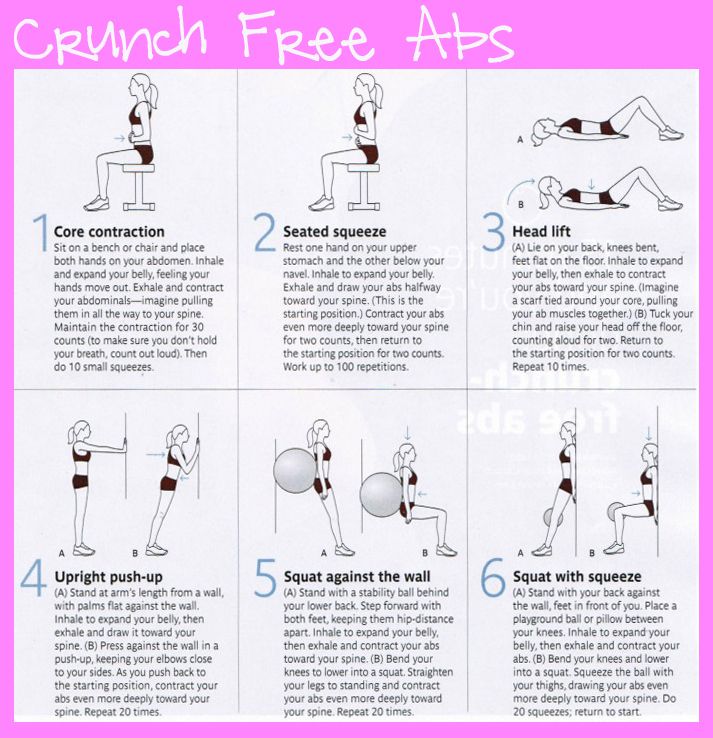
To modify, take out the leg lower and only perform the leg extensions.
6. Elevated Leg Extension + 2 CirclesTargets: transverse abdomen, upper abs, lower abs and hips.
- With your low back pressing firmly into the mat and your abdominal wall wrapped as tightly as possibly around your core, bring your legs to a 90 degree bend.
- Note, the closer your knees are to your chest the easier this ab exercise will be. The farther your knees are from your chest, the harder this Diastasis Recti exercise will be.
- Alternate extending one leg straight out, then slowly draw two donut-sided circles with the big toe of your extended leg.
- Return to the starting position, and repeat on the other side. This movement is slow and controlled.
To modify, perform one circle or take out the circles and only perform the leg extensions.
7. Elevated Bent Knee V-Taps (2 count on the way down and up)
Elevated Bent Knee V-Taps (2 count on the way down and up)Targets: transverse abdomen, upper abs, lower abs, hips, adductors and pelvic floor.
- With your low back pressing firmly into the mat and your abdominal wall wrapped as tightly as possibly around your core, bring your legs to a 90 degree bend.
- Note, the closer your knees are to your chest the easier this ab exercise will be. The farther your knees are from your chest, the harder this Diastasis Recti exercise will be.
- Maintaining the 90 degree bend in your legs; open both legs, lowering your toes towards the outside of your mat on a 2-count.
- Tap your toes on the outsides of your mat, then return to the starting position on a 2-count, squeezing your knees and inner thighs to touch as you return. This movement is slow and controlled.
To modify, drop only one leg to the outside of the mat and return to the starting position, then dropping the other leg.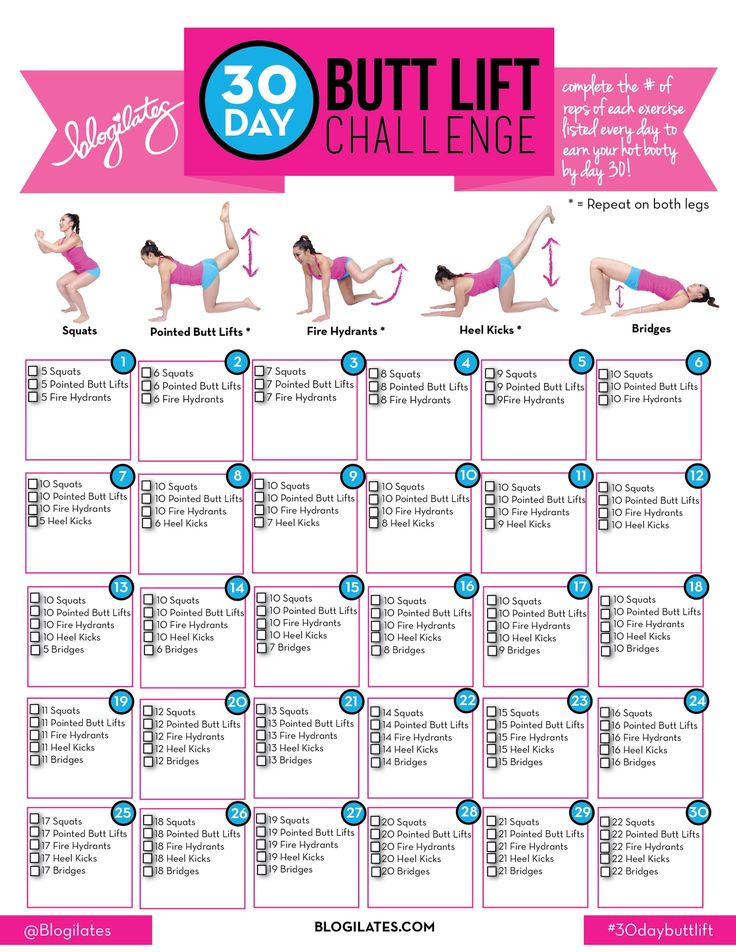 Alternating legs versus dropping both legs at the same time.
Alternating legs versus dropping both legs at the same time.
Targets: transverse abdomen, upper abs, lower abs, hips, adductors and pelvic floor.
- With your low back pressing firmly into the mat and your abdominal wall wrapped as tightly as possibly around your core, bring your legs to a 90 degree bend.
- Note, the closer your knees are to your chest the easier this ab exercise will be. The farther your knees are from your chest, the harder this Diastasis Recti exercise will be.
- Bring your feet to ‘first position’, heels touching and toes out making a ‘V’ with your feet.
- Then slowly kick both heels out, away from your body on a 2-count; squeezing your inner thighs to touch as you reach full extension.
- Note, extending your legs more upward, toward the ceiling will make this ab exercise easier. And extending your legs straight out, pr closer toward the ground will make this ab exercise more challenging.
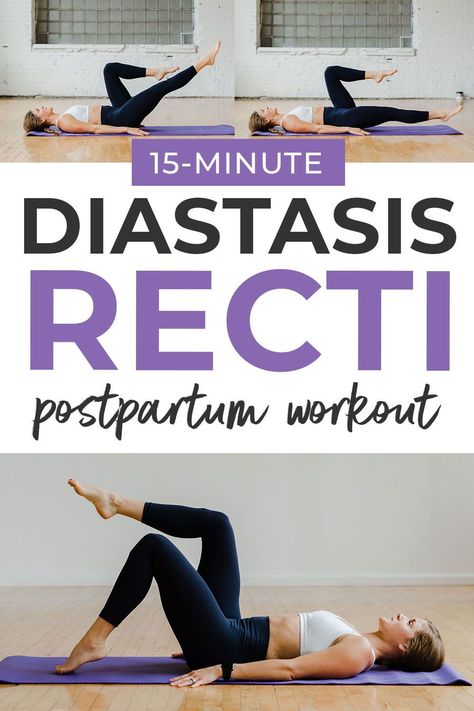
- Then return to the starting position on a 2-count, pulling your knees back towards your chest at a 90 degree bend. This movement is slow and controlled.
To modify, kick out only one leg, return to the starting position, then kick out the other leg. Alternating legs versus kicking out both legs at the same time.
More Exercises for Diastasis Recti Repair
Once you’ve mastered this 10 minute abs after baby workout, you can advance to these postpartum-friendly ab workouts:
- 10 Minute Lower Ab Workout
- 10 Minute Beginner Ab Workout
You might also like my FREE, 30 Day Postpartum Workout Plan — an at home postnatal workout program.
More Post-Baby Workouts:
- 10-Minute Beginner Cardio (No Equipment, No Jumping)
- 10-Minute Low Impact HIIT for Beginners (No Jumping)
- 15-Minute Abs, Butt and Thigh Workout
- 7 Best Strength Training Exercises for Women
Pin these Diastasis Recti Safe Ab Exercises
Download the press after childbirth | How to do it right?
It is said that a woman's body changes completely after childbirth. Almost everything changes - attitudes towards food, nutrient absorption, the rate of muscle growth, or in other words, muscle response. And they also say that after childbirth it is impossible to find a visually marked press and achieve its maximum relief. Deception? Let's figure it out. What is abs? Women after childbirth often pay attention to the "lag" of the lower abdomen, since it is in this place that subcutaneous fat accumulates, which in turn prevents the press from being noticed. In fact, there are no so-called parts. There is a longitudinal press - these are the same cubes along the abdomen, the transverse muscle - it is under the longitudinal, and two oblique ones. In order for there to be a visible result in working with the press, it is not enough to do twisting. It is necessary to increase the time of cardio and the number of static exercises. We remember that the relief press is an indicator of a low level of subcutaneous fat on the abdomen. nine0003
Almost everything changes - attitudes towards food, nutrient absorption, the rate of muscle growth, or in other words, muscle response. And they also say that after childbirth it is impossible to find a visually marked press and achieve its maximum relief. Deception? Let's figure it out. What is abs? Women after childbirth often pay attention to the "lag" of the lower abdomen, since it is in this place that subcutaneous fat accumulates, which in turn prevents the press from being noticed. In fact, there are no so-called parts. There is a longitudinal press - these are the same cubes along the abdomen, the transverse muscle - it is under the longitudinal, and two oblique ones. In order for there to be a visible result in working with the press, it is not enough to do twisting. It is necessary to increase the time of cardio and the number of static exercises. We remember that the relief press is an indicator of a low level of subcutaneous fat on the abdomen. nine0003
When can I start doing abs?
In this matter, it is important to pay attention to the individual characteristics and severity of childbirth.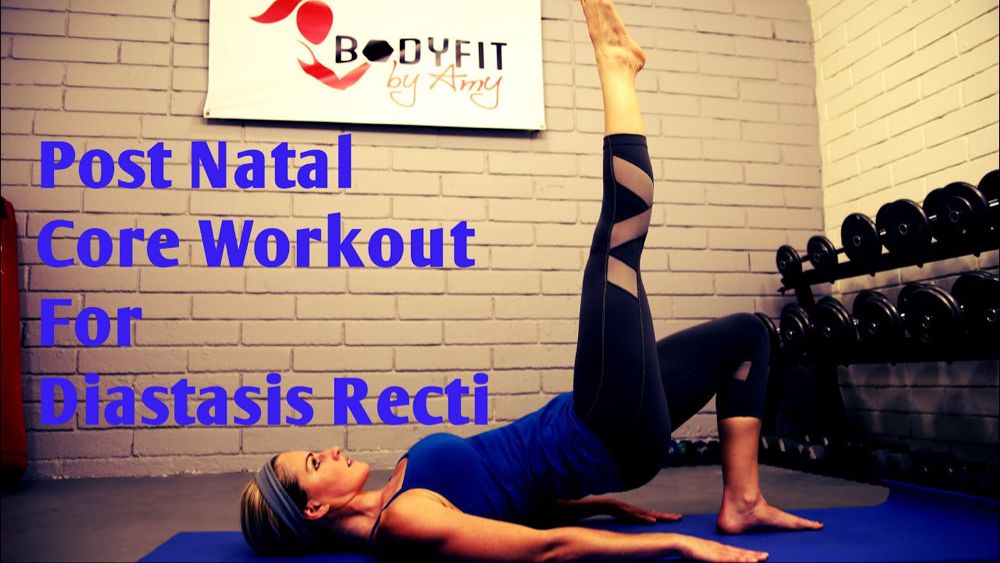 Natural childbirth or caesarean section, how quickly the uterus returns to its original state, were there any complications, what is the hormonal background, etc. In any case, only the attending physician can give the correct recommendations, he will also guide you in terms of timing. The average indicators (this is when all examinations after childbirth are within the normal range) show that after natural childbirth, you can start training the press after two months, after a cesarean section - after 3-4 months. Attention, if after the start of training you feel discomfort, non-specific pain, bloody discharge or other unusual symptoms appear, then you need to stop training and consult a specialist. nine0003
Natural childbirth or caesarean section, how quickly the uterus returns to its original state, were there any complications, what is the hormonal background, etc. In any case, only the attending physician can give the correct recommendations, he will also guide you in terms of timing. The average indicators (this is when all examinations after childbirth are within the normal range) show that after natural childbirth, you can start training the press after two months, after a cesarean section - after 3-4 months. Attention, if after the start of training you feel discomfort, non-specific pain, bloody discharge or other unusual symptoms appear, then you need to stop training and consult a specialist. nine0003
Features of training after childbirth
1. Start small
Even if you were an avid athlete before pregnancy, any physical activity after childbirth should begin with small loads, increasing gradually. The same goes for the press - start small. Start from the number of repetitions per day, and each time do ten times more.
Start from the number of repetitions per day, and each time do ten times more.
Do not immediately resort to large weights or heavy loads. It makes no sense. Our task is not to increase muscle volume, but to reduce the amount of fat in the problem area. nine0003
2. Warm-up
Hormonal changes in the body during pregnancy lead to an increase in subcutaneous fat. Most of it is most often a layer on the stomach, which is not easy to get rid of in the future. Therefore, first take the time to warm up, warm up properly, do cardio or dance, play active games with your child, or just do high-rep simple exercises.
3. Breathing
Set up correct breathing so that you can do it intensively and rhythmically. Tighten your muscles as you exhale, pull in your stomach.
4. Regularity
Regularity is the key to success. For our press, exercises are needed every day.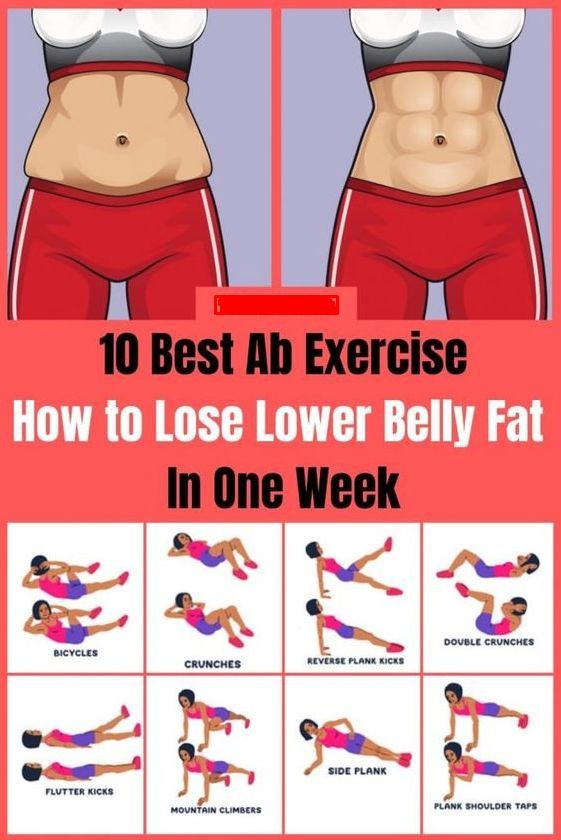 It is better to do it in the morning, an hour before breakfast or two hours after it.
It is better to do it in the morning, an hour before breakfast or two hours after it.
What is diastasis?
Not always a round belly and a disproportionate waist indicate an incorrect and sedentary lifestyle. This person may have diastasis. Diastasis is a separation of the longitudinal muscles of the abdomen. Most often this occurs due to childbirth, and also appears in people with a hereditary predisposition, obesity and weak abdominal muscles. nine0003
Determining the presence of diastasis is very simple. Get into a crunch position, place your feet as close to your buttocks as possible, and start twisting. At this time, feel the abdomen along the press with your fingers. If by sensations you have identified a hollow between the longitudinal muscles of the abdomen, you should think about the presence of diastasis.
What to do?
This pathology can lead to a number of problems in the future.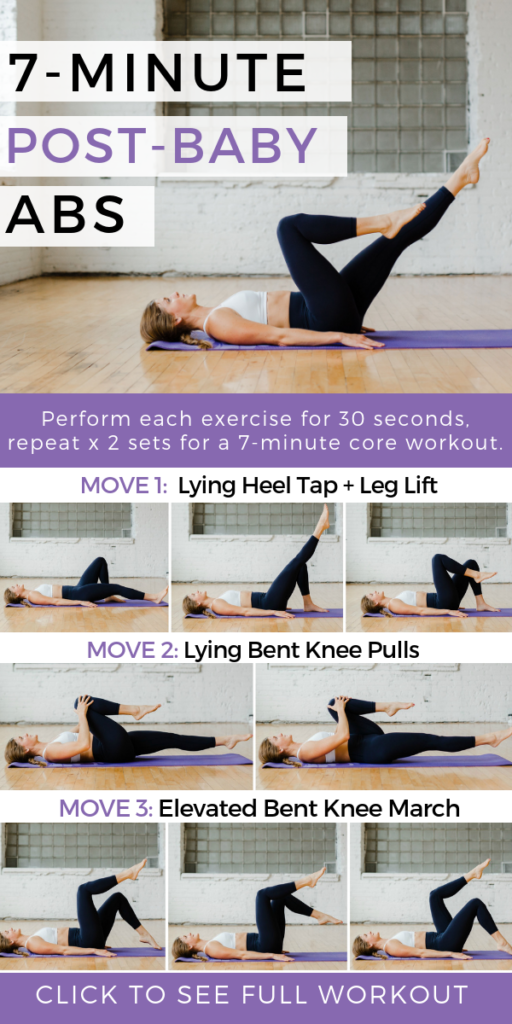 This is the risk of hernias of various localization, and disruption of the digestive system, diseases of the spine, etc. nine0003
This is the risk of hernias of various localization, and disruption of the digestive system, diseases of the spine, etc. nine0003
It is important to choose the right set of exercises to work on diastasis. Use bodyflex in your workouts. The alternation of inhalation and exhalation during exercise increases their effectiveness. There are exercises that you need to exclude from your program, these are those that can contribute to the occurrence of hernias (deadlift, lifting the pelvis-birch). In this case, it is better to use a pull-down belt or a supporting corset. With diastasis, only a balanced diet is recommended, foods should help digestion, fiber must be present. At first, it is better to choose breathing exercises - “pulsating the abdomen”, “pulling in the abdomen”, and then move on to more complex ones, for example, “modernized bicycle” or “alternating breathing”. nine0003
Abdominal exercises after childbirth
1. Glute bridge
Although the word "gluteal" appears in the name of the exercise, it is done with an emphasis on the press.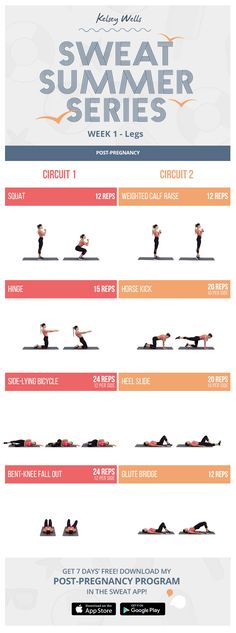 It gives the softest effect on the abdominal muscles. Take a prone position, bend your knees, tighten your abs and lift your pelvis.
It gives the softest effect on the abdominal muscles. Take a prone position, bend your knees, tighten your abs and lift your pelvis.
2. Classic crunches
Lie down, knees bent, hands in front of you or slightly touching the back of the head. As you exhale, lift your shoulders and head and pull them towards your knees. nine0003
3. Plank
An exercise that will strengthen not only the abs, but also other muscle groups. Lying position on the floor. Raise your whole body, standing on straight arms or on your elbows. As a result, the body stands on the hands and toes, parallel to the floor. Try not to lift your pelvis.
4. Bicycle
Lie on your back. Raise your legs at a 60-degree angle and simulate pedaling.
5. Lying Leg Raise
Lying on your back, lift your straight legs to a 45 degree angle, hold for 10 seconds and return to the starting position.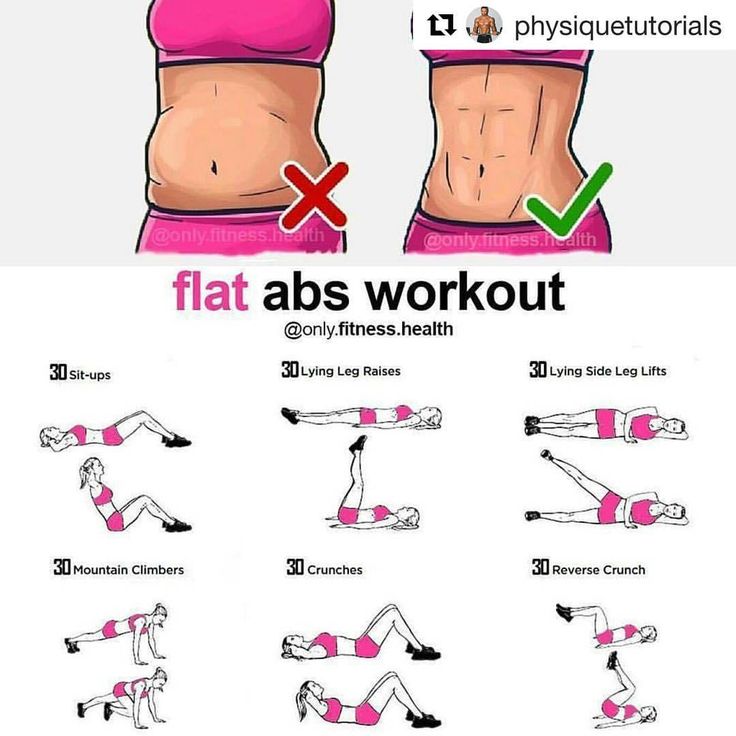
Conclusion
Dear mothers, do not chase after a flat stomach! Each of us has a different body, and each of us needs a different time to recover after childbirth. Therefore, be patient, devote more time to your child. Balance your diet. You will feel when you are ready for a new stage. But when that time comes, then only forward! If you have gained excess weight, then one work on the press is not enough. In this case, it is better to contact a qualified trainer for the right program. nine0003
Without cardio, kilograms will not go anywhere. Be sure to take tests for hormones and be attentive to your feelings. After all, a woman's body changes after childbirth, and some things have to be perceived in a new way. Be healthy!
Abs after childbirth - when to start and what is prohibited
Contents
After childbirth, in the vast majority of cases, the figure of a woman changes significantly. This is especially true of the abdomen, the muscles of which become weakened, and the skin stretched and flabby. Looking at themselves in the mirror after discharge from the hospital, many women are immediately determined to bring themselves into a prenatal state and achieve a perfectly flat stomach. The desire is understandable and quite commendable, however, newly-made mothers should understand that it is unlikely to be realized instantly. nine0003
This is especially true of the abdomen, the muscles of which become weakened, and the skin stretched and flabby. Looking at themselves in the mirror after discharge from the hospital, many women are immediately determined to bring themselves into a prenatal state and achieve a perfectly flat stomach. The desire is understandable and quite commendable, however, newly-made mothers should understand that it is unlikely to be realized instantly. nine0003
When can I start doing abs after childbirth
It will be possible to achieve the goal of getting her body in shape after a while, if a woman persists, eats right and exercises it reasonably. Starting to pump the press after childbirth, without waiting for the body to recover and be ready for active sports exercises, can cost a woman certain health problems. The duration of the rest period after childbirth - the time without any serious physical exertion - is individual and depends on how the delivery took place. nine0003
During natural childbirth, do not start active physical training, including pumping the press after childbirth, for about 7 weeks.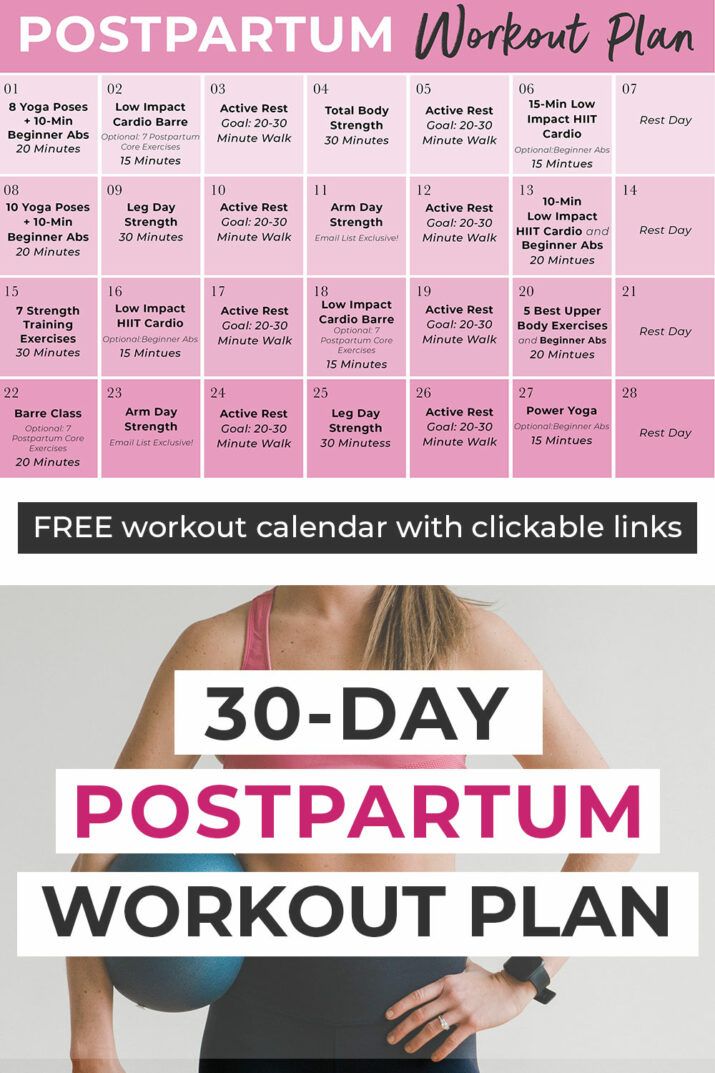 After a cesarean section, which is essentially a surgical intervention, this period depends on the condition of the scars after the operation, and with normal indicators, the period increases to 12 weeks.
After a cesarean section, which is essentially a surgical intervention, this period depends on the condition of the scars after the operation, and with normal indicators, the period increases to 12 weeks.
Contraindications for abdominal exercises after childbirth
In some cases, the question of when it is possible to pump the press after childbirth can only be answered by a doctor after consultation and additional examination. This is especially true for situations where a woman decided to pump the press with diastasis. Its presence suggests exercises for the press, which are different from the usual ones. nine0003
Caesarean section and diagnosed diastasis require a visit to a doctor and a decision on whether a woman can start training or not. In addition, there are contraindications in which the doctor will unambiguously prohibit heavy physical exertion and sports exercises, including the press after childbirth.
Such contraindications include:
- damage to internal organs;
- scars on the uterus;
- spotting; nine0142
- inflammatory diseases of the pelvic organs.

These symptoms make it impossible until cured training and exercises that involve the abdominal muscles.
Tips for starting workouts
You need to be careful not to exhaust yourself with long workouts in the fight for a flat stomach. A woman, even if she has no contraindications, should do exercises for the press in accordance with her level of physical fitness. In the matter of restoring the press after childbirth, it is not the number of approaches and not the intensity that is important, but the regularity. You need to start by practicing the correct technique for the abdominal exercises included in the training program. And not immediately, but after preparing the body for stress. Yoga, Pilates and light cardio workouts are the best for this purpose. nine0003
Breathing exercises that develop the diaphragm can help. Such exercises will tone the muscles, and it will become safer, more effective and easier to work on the press after childbirth. But the desire to pump up the press without preparation after childbirth can lead to a weakening of the pelvic floor muscles and the omission of internal organs.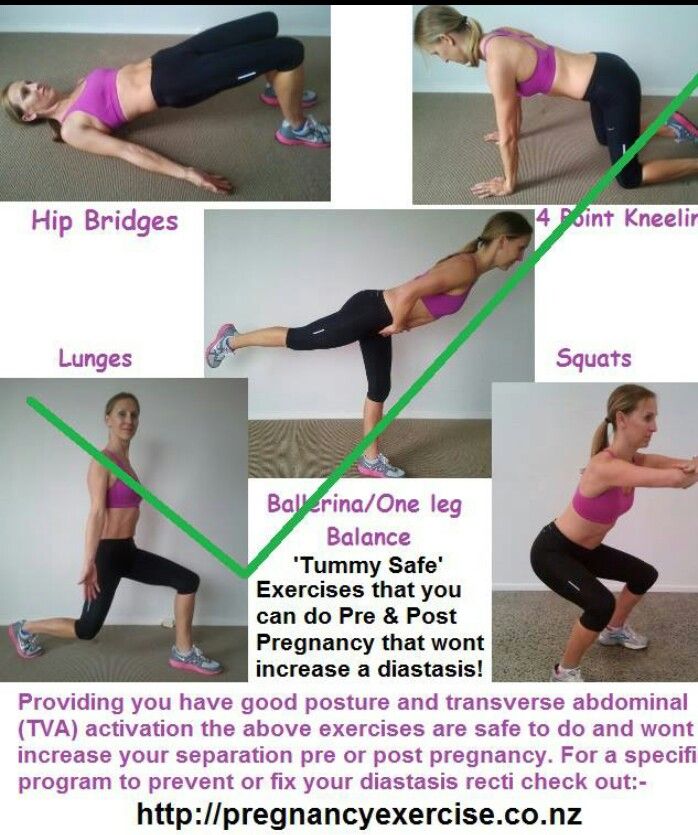
Basic exercises for the press
After preparing the body for physical activity, you can proceed to the basic exercises to restore the press after childbirth - "Birch", "Reverse Bridge" or "Vacuum". The first two exercises should be done in the starting position “lying on your back”. When doing the “Birch”, support the hips with your hands, lifting your legs up, which helps to strengthen the lower press. With the “Reverse Bridge”, the legs are bent at the knees, lifting the hips up, bending in the back and then slowly lowering to the starting position. nine0003
First, repeat the exercise 10-15 times per set. In addition to the ability to quickly pump up the press after childbirth, such an exercise will help tighten the hips and buttocks. Performing the “Vacuum”, they take a deep breath with the stomach, exhale smoothly, pulling it back and forth, hold their breath and fix in this position until you can not breathe. Then release the stomach and take a smooth breath.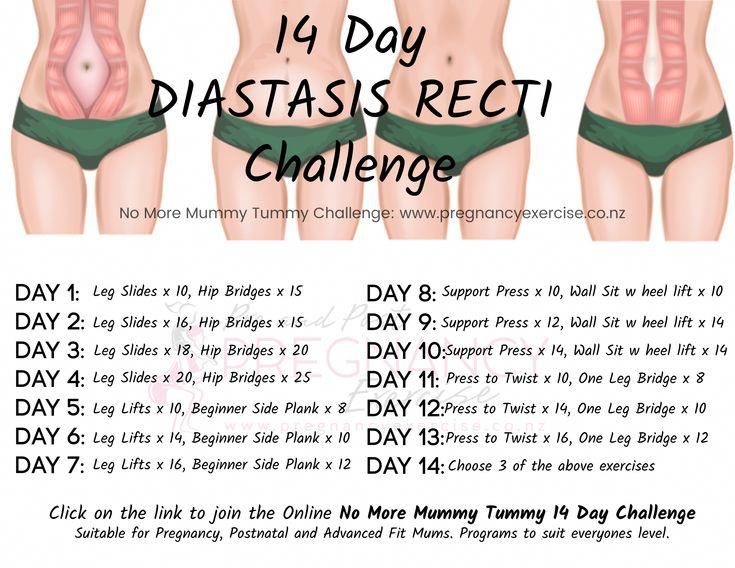 For beginners, 3-5 repetitions are enough.
For beginners, 3-5 repetitions are enough.
Additional exercises effective for pumping the press
Exercises available at home - Bicycle, Plank and Lift. They are simple and give a good effect if you want to quickly restore the press after childbirth. “Bicycle” is done lying on your back and raising your legs at an angle of 60 degrees, simulating the rotation of the pedals. The Planck universal exercise will strengthen not only the press, but also other muscle groups. It is done by lying on the floor with the body raised on the elbows or straight arms so that it is parallel to the floor.
Not so common, but effective for restoring a tucked-up abdomen after childbirth, is the “Lift” exercise. Sitting on the floor and pressing the back and shoulders against the wall, hands are placed on the stomach, mentally imagining that the abdominal muscles are an elevator that needs to be raised and lowered from the first floor to the last with a straight back. Then alternately raise the "elevator" from 1 floor to 2, from 1 to 3 and so on, while holding the abdominal muscles for 3-5 seconds. nine0003
nine0003
Step-by-step online recovery program after childbirth
And in 3 months or less, not only physical fitness will return to you, but also mental balance. Happy mom, happy family!
- Yoga and cardio after EP or CS
- Consultations with experts
- Nutrition program
- Psychological support
- SPA: Beauty rituals at home
- Life hacks and podcasts
Start now! First 3 days free
Exercises with a fitball and with a baby
One of the most gentle ways to pump the press after childbirth is exercises on a fitball. They perfectly tone the abdominal muscles with minimal stress on the back. One of these exercises is performed in the starting position lying on the floor with straight legs lying on the fitball. The hips are lifted up, rolling the ball back and forth with alternating movements of the legs. In addition to restoring the press after childbirth, the exercise contributes to the development of the muscles of the chest and buttocks. nine0003
nine0003
You can combine business with pleasure by doing exercises with your baby at home, when, in addition to training for the press, the mother spends time with the child, paying attention to him and delivering positive emotions. Do the exercise, standing against the wall with straight legs. One leg is bent at the knee and raised. The baby needs to be seated on the thigh of the outstretched leg and rock the child up and down. Then you need to repeat the same for the second leg.
Diastasis - a special attitude to the restoration of the press
A special approach to rocking the press after childbirth should be used if a woman is diagnosed with postpartum diastasis. This term means the divergence of the press, abdominal muscles along the center line. To check if a woman has diastasis, she can independently at home. To do this, you need to lie on the floor, bend your knees, raise your torso, straining your abs.
The appearance between the rectus abdominis muscles when probing the cleft indicates the presence of diastasis. This means that after childbirth, special exercises for the press will be required, and it will also be necessary to wear a bandage. With a rupture of the press and physical exertion, it will protect damaged muscles and contribute to their faster return to their original state. nine0003
This means that after childbirth, special exercises for the press will be required, and it will also be necessary to wear a bandage. With a rupture of the press and physical exertion, it will protect damaged muscles and contribute to their faster return to their original state. nine0003
Exercises for diastasis
The restorative exercises for diastasis themselves also differ from those that can be recommended after childbirth for women who do not have a press discrepancy or by the time the rest period ends and the transition to the active phase it has been eliminated by itself. First of all, as already mentioned, you need to consult a doctor. And if he does not object to the start of training for the press after childbirth, proceed to classes. Classical training of the press must be categorically excluded, otherwise all efforts will lead to an increase in diastasis and, as a result, the growth of the abdomen. nine0003
Experts advise a unique exercise that can be done while sitting, standing, lying down, without being distracted from other activities:
- pulling the stomach in, "stretch" the navel to the spine;
- alternating relaxation and retraction, create fast pulsating movements;
- breathing is even, without delay.
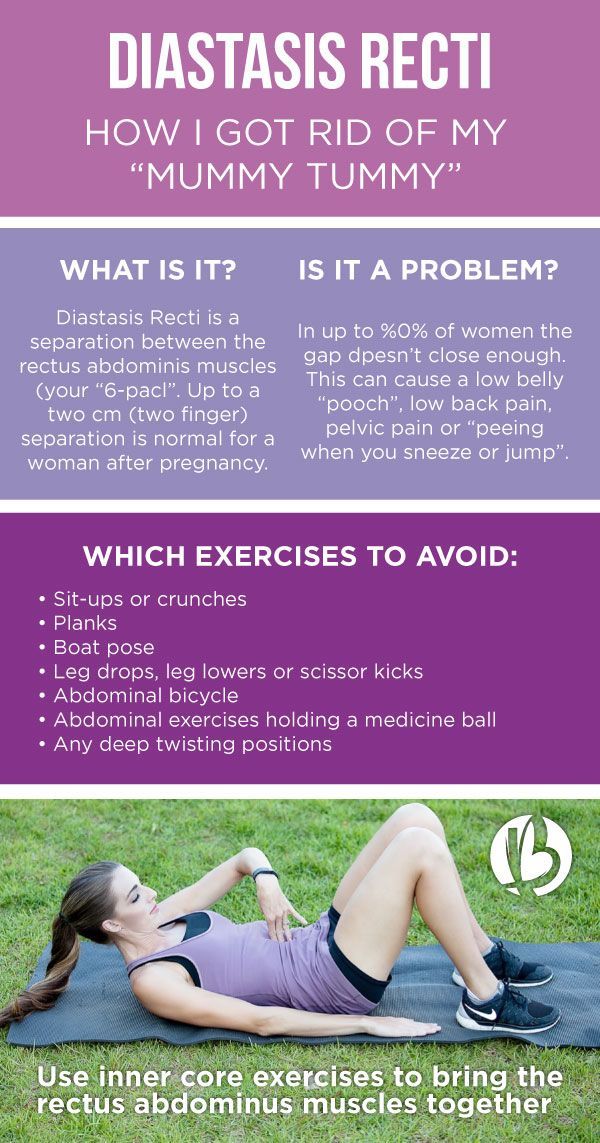
Such pulsations of the abdominal muscles should be performed no more than 100.
What else to do with diastasis
Exercise to retract and relax the abdominal muscles is effective, but not the only one that can help women who have had a postpartum rupture of the press to regain shape after childbirth . Experts consider the exercise "Cat" to be effective. To perform it, you need to get on all fours, drawing in your stomach, and arch your back. Then, on the contrary, the stomach must be pulled in, and the back should be bent in an arc to the floor. nine0003
An exercise that is repeated 10-15 times while lying on your back will help in restoring the press in case of diastasis. As you exhale, raise your head off the floor and press your chin to your chest. The abdomen should be pulled in. On inspiration, they return to their original position. It is also recommended to stretch the lower back with a repetition of 10-15 times in each direction. It is done by turning the head in one direction, and the legs, bent at the knees, in the opposite direction, lingering in this position.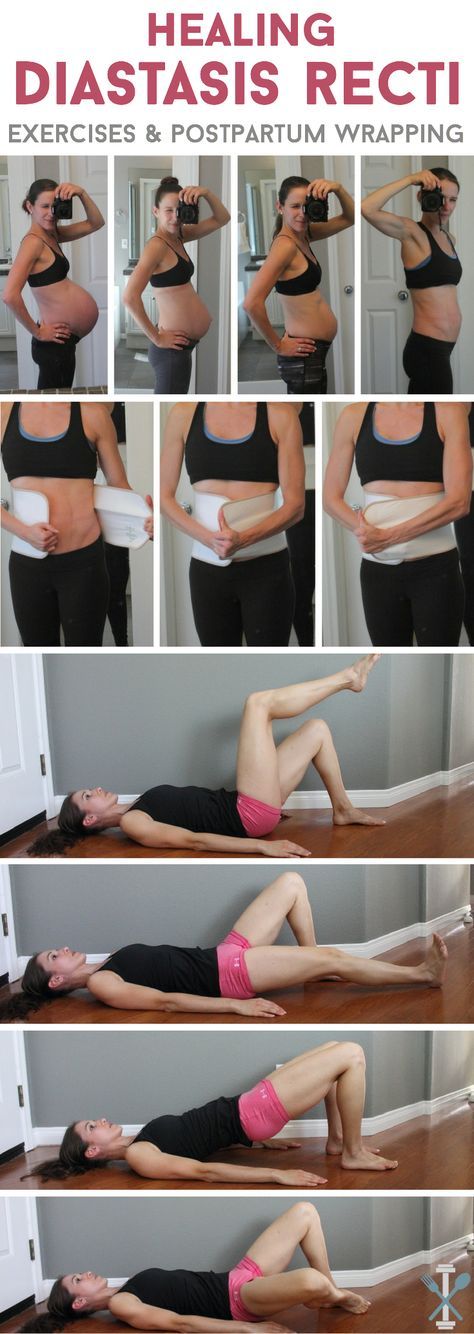 It is important to keep the stomach pulled in. nine0003
It is important to keep the stomach pulled in. nine0003
How to increase the load over time
Over time, the load can be gradually increased. To remove the stomach, you need to gradually increase the number of exercises included in the daily workout at home. At a time when the body has already fully recovered, and the doctor does not mind going to the gym, you can increase the time spent in training. Gradually and carefully, you can complicate the exercises themselves, adding elements to them that make their implementation more difficult. nine0003
Progressively it is worth increasing the number of repetitions of this or that exercise. For example, starting with a couple of approaches, you can gradually increase their number to 5. The intensity of training should also increase at the same time. A competent integrated approach to increasing physical activity will certainly give good results and allow you to quickly restore a flat stomach after childbirth.
Our online course offers a program for young mothers, which is aimed, among other things, at strengthening the abdominal muscles.